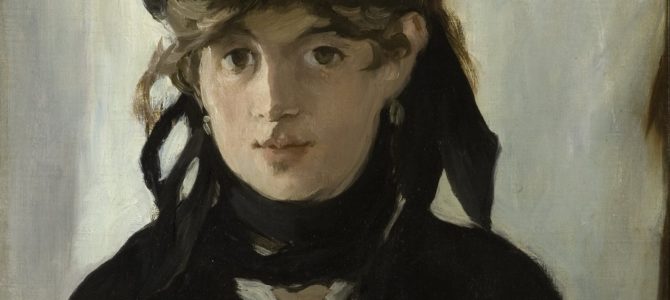
If you’ve not heard of Berthe Morisot (1841-1895), the exhibition “Berthe Morisot: Woman Impressionist,” which just opened at the Barnes Foundation in Philadelphia, is an excellent opportunity for you to rectify this glaring error in your art education. Morisot was one of the most prominent members of the French Impressionist art movement of the second half of the 19th century, alongside artists whose names are probably more familiar to you, such as Édouard Manet, Claude Monet, and Edward Degas.
The exhibition, which comes to Philadelphia from Quebec, and will be moving to Dallas early next year before finishing up in Paris, shows some of Morisot’s best work, while attempting to address the very unfortunate fact that she has been overlooked for far too long by both the art establishment and the general public. Unfortunately, the organizers seem to have become so wrapped up in their social science theories that one is best advised to simply go along and admire the paintings, while skipping most of the accompanying text.
What You’ll Find in Philadelphia
The Philadelphia incarnation of the show has close to 70 works, divided into a series of interconnected rooms that are organized thematically, rather than chronologically. Thus, one space features outdoor imagery, while another features canvases of women engaged in domestic activities. There are portraits, mainly of Morisot herself or her family members, as well as landscapes and seascapes, and scenes of everyday life.
The placement of temporary walls to divide the long spaces is only partly effective in highlighting particular works of art. The visitor can’t always be sure that there is a painting to see on either side of a dividing wall. Moreover, the divisions create a bottleneck, particularly when, as on a weekend, the gallery is rather full, and circulation becomes difficult.
Paintings such as Morisot’s “Young Woman in Gray Reclining” (1879, private collection), which was chosen as the cover image for the exhibition catalogue, are the sort of thing one generally expects from an Impressionist painter: fashionable, pleasant, easy to like, and having little in the way of depth.

Similarly, “Reading with Green Umbrella” (1873) from the Cleveland Museum of Art, with its clever observation of the effect that a net veil has on the face of a woman wearing it, is a classic image of a well-dressed woman reading the latest from Zola or Verlaine while enjoying the semi-tamed French countryside.

If you like French Impressionist painting (on the whole I don’t), you’ll certainly enjoy the images of pretty Parisiennes doing their toilette, or figures languidly sprawling about in the garden watching children play. There is plenty of that sort of thing in this exhibition.
Following Berthe Morisot’s Development
I think the real interest of this show is to see how Morisot developed as an artist. Three of her remarkable, almost vertically oriented seascapes, for example, such as “English Seascape” from the Newark Museum, painted while in England in 1875, are included in the show and were unknown to me. One can see how Morisot is trying to show frenetic movement and bustling activity along the quays and docks of the harbor, as seen from an unusually high vantage point. Her canvases almost prefigure the cityscapes of the English painter L.S. Lowry (1887-1976), working more than a generation later.

In a completely different vein, and very much against the hyper-saturated coloring of her Impressionist contemporaries, Morisot sometimes chose to exert her artistic self-confidence in self-restraint, by deliberately leaving a canvas looking unfinished. In the arresting “Portrait of Miss L[ambert] (Isabelle in the Garden)” (1885), from a private collection, one immediately recalls watercolor studies by John Singer Sargent or James Abbott McNeill Whistler, and the influence of Japanese woodblock prints, but the idea of leaving the painting in this unfinished state rather than filling every inch of the canvas was a radical departure for the time.
Another painting from the same year is a confident self-portrait of the artist from the Musée Marmottan Monet in Paris, where again the canvas is left partially bare. Even before reading the accompanying placard, one is struck by the almost martial aspect of the image, which could be that of a Bonapartist. The placard tells us that Morisot’s friend, the French Symbolist poet Stéphane Mallarmé, noted that the flowers adorning the jacket look like military decorations.

Echoes of Symbolism
Symbolist art is often looked at as a precursor to what today we would consider Modern art: painters such as Gustav Klimt and Odilon Redon created images that were often quite strange, full of mysticism, legends, and poetic references. To visit these unreal worlds in their often highly sensuous art, these painters loved using the sorts of colors that tell us we are entering a dreamscape.
Along those lines, “Julie Daydreaming” (1894, private collection), a portrait of the artist’s daughter, is perhaps the most un-Morisot Morisot in the exhibition, for the very reason that it could fit neatly into an exhibition of symbolist art. Note the use of the almost eerie greens in both the rippling background and the skin tones, for example.

Julie’s auburn hair contains red, particularly a bold shock of it above her left eye and against her left cheek, but it contains a wealth of other colors as well, including green, yellow, orange, black, and brown. Here, Morisot has captured a girl of 16 who is about to become a woman, appearing dreamily unaware of how she is about to leave her childhood behind for good.
Read the Paintings, Not the Words
For all the strength of such images that make up the exhibition, the inherent weakness of this show lies in the text rather than in the art. The exhibition catalogue spends a great deal of time expostulating upon the application of feminist theory and gender studies to Morisot’s work. It is, at times, a disturbing volume, and also a confusingly organized one.
If the goal was to create a foundational text for reappraising Morisot as an artist by making a well thought-out, systematic argument that she should occupy the same lofty height of public reputation as her male contemporaries, then the authors have failed.
The real problem with the catalogue, however, which is repeated in some of the text placards accompanying the paintings, lies with the content. For example, Morisot’s masterpiece is usually considered to be “The Cradle” (1872) from the Musée d’Orsay, which features prominently in the show. It’s hung on a blue dividing wall by itself, so the visitor can’t miss it.

It shows Morisot’s sister, Edma, tending to her daughter, Blanche, who is asleep in an elaborately canopied cradle. I particularly love the way some shorter wisps of hair have escaped from the lady’s elaborate coiffure, and are spread along the bare skin at her right temple. You get the impression that this is a mother who is very involved in the care of her infant. Perhaps the child has been ill or is teething, and with tender concern, she is keeping a watchful eye over her baby.
Unfortunately, that’s not how the exhibition organizers want you to see this picture. While the Orsay describes the piece as having “the feeling of intimacy and protective love,” the accompanying placard and exhibition catalogue for the current show tell us it is about “the ambiguity of motherhood,” giving a darker read to what a reasonable person would take as being nothing more than a mother being attentive to a baby.
In effect, the exhibition deliberately tries to ruin the positive effects of the canvas on the viewer by suggesting, without actually saying, that Edma is having second thoughts. The mothers reading this article will have to decide for themselves whether it is reasonable for the organizers of this show to have, in effect, turned what otherwise appears to be an image of genuine motherly affection, concern, and self-sacrifice into an advertisement for childlessness.
Weird Obsession with Morisot’s Personal Appearance
Then we must consider the catalogue’s and exhibition’s focus on Morisot’s appearance. Morisot portrayed herself in a number of her pictures, and she modelled for a number of other artists. One particularly famous example of this is “The Balcony” (1868-69) by her brother-in-law, Manet, where Morisot is shown seated, glaring with furrowed brow at someone or something.

The catalogue describes Morisot as being strikingly beautiful, and perhaps in the eyes of those of her time she was, but in both contemporary paintings and photographs, she often seems an almost sinister figure, particularly as compared to her radiantly beautiful daughter, Julie.
More to the point, and a question the exhibition organizers never seem to answer: what is the relevance of Morisot’s personal appearance to her abilities as an artist? This is an art exhibition, not an historical exhibition on the life of a 19th-century French model. We are repeatedly told that Morisot was physically beautiful, but surely feminist theory if consistently applied (ha) would insist that our response to such an assertion ought to be, “So what?”
In any case, weren’t we supposed to have stopped making connections between a woman’s personal appearance and her professional abilities a long time ago?
Then there is the issue of culpability, for one cannot attend an art exhibition centered upon gender theory without being told that someone (usually a man) is to blame for something. In this case the exhibition seems just as intent on finding a scapegoat for Morisot’s current lack of prominence as it is on actually celebrating her work.
There’s no question that Morisot was badly treated by a number of her male contemporaries because she was a woman and they could get away with it. I have loved Morisot’s work for quite a long time, and I remember as a child being horrified to learn that Manet thought a painting Morisot had completed wasn’t strong enough, and he took a brush of black paint to it to make a figure in the painting more intense.
To put it mildly for the sake of linguistic propriety, this was a total jerk move. He would not have dared to do the same thing to, say, the work of a male colleague like Henri Fantin-Latour or Paul Cezanne.
The Exhibit Doesn’t Present the Full Context
Yet we also learn from the exhibition that Morisot’s husband Eugène Manet, brother of the more famous Édouard and himself a painter, essentially gave up his own artistic career to support his wife full time, recognizing that she was a far better artist than he. Even after she married and her reputation grew, Morisot continued to sign her work using her maiden name, to which neither her husband nor other contemporaries seem to have objected. It is perhaps in this area of reputation where the exhibition, or at least the catalogue, makes a fatal error regarding the preeminence of its subject.
The exhibition goes to great pains to point out that, at one time, Morisot was held in just as high esteem as the more famous French Impressionist painters with whom we are all now familiar, but over time her prominence declined, perhaps due to sexism. Part of the problem with this analysis is that, unlike the majority of her contemporaries, Morisot came from a well-to-do family, and not only did she not have to work for a living, but she usually did not care that much whether her paintings sold or what prices they fetched.
Whatever romantic vision one may have of struggling Impressionist artists in 19th-century Paris, Morisot never had to live in some back street garret shivering over an old stove, or haggle with her dealer to squeeze a few more coins out of a sale. In the pursuit of her craft, Morisot didn’t seek out higher sales or more prominent commissions, which are often the economic and reputational lifeblood of most professional artists, so that after her death the vast majority of her work was owned by family and friends, rather than displayed in public galleries or prominent private collections.
Meanwhile, Morisot’s better-known friend and contemporary, Mary Cassatt (1844-1926), who came from a similar social background and also suffered from chauvinist attitudes toward her art, not only actively marketed her work to prominent collectors and galleries, but also received commissions, such as the massive, 58-foot-long mural (now sadly lost) for the famous World’s Columbian Exposition in Chicago in 1893. If Morisot chose not to market herself, as other artists of her time did, or insist on a more active representation of her work by those who carried her paintings in their galleries, then surely the fault for her present-day lack of prominence must at least partly lie at her own feet.
With all of that being said, whether the artist under consideration is woman, man, or space alien, the real question that a visitor to a retrospective such as this needs to ask is: Does the art hold up? For Morisot, it certainly does and, in a number of instances, it’s absolutely brilliant stuff. The pity is, it seems that at least some of those who put this show together lack the confidence required to allow Morisot’s work to stand or fall on its own artistic merits, without putting an unnecessary gloss atop it.
Should you find yourself within proximity of this exhibition over the coming months, by all means go see it. Only be judicious with reading some of the placards. Don’t bother buying the exhibition catalogue, either.
“Berthe Morisot: Woman Impressionist” is at the Barnes Foundation in Philadelphia until January 14, 2019. It will then move to the Dallas Museum of Art from February 24-May 26, 2019. It will finish up at the Orsay in Paris from June 18-September 22, 2019.









